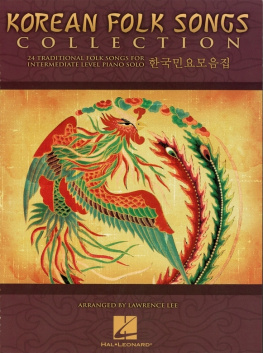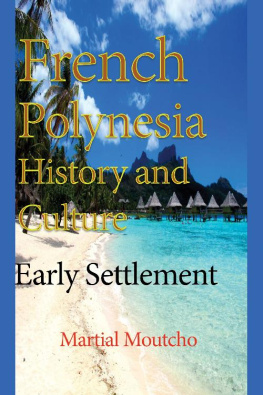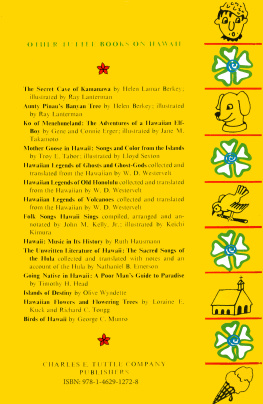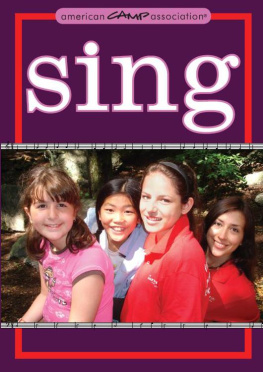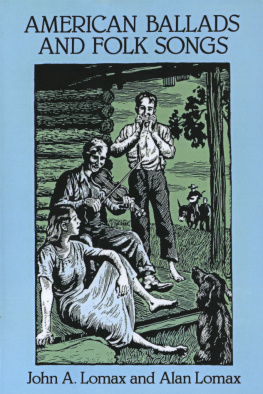
Aloha 'oe
Farewell to Thee
HAWAII

"Aloha 'Oe" is Hawaii's most famous song. Although far from being anonymousQueen Liliuokalani, Hawaii's prolific song-writing monarch, composed the verses in 1878, a few years before the turbulent end of the Hawaiian kingdomit occupies a place in the hearts of the people of Hawaii comparable to that of the best-known folk songs.
The tune of the verse is remarkably close to "The Rock Beside the Sea," by the American composer Charles Crozat Converse, published in Philadelphia in 1857, while the chorus tune is attributed by Sigmund Spaeth to the chorus of George Frederick Root's "There's Music in the Air," published in 1854.
Mary Kawena Pukui remembers the story told by Lahilahi Webbboth ladies being among Hawaii's most outstanding historiansof a visit by the queen and her attendants to Maunawili, a lovely mountain retreat on the windward side of Oahu just below the famous pali (cliff). As the party mounted their horses for the return to Honolulu, the queen's imagination was caught by the affectionate parting of a young man in her company and a lovely girl of the locality. As the party rode home the queen was humming softly, and the verses of "Aloha 'Oe" came into being.
There exists in the George R. Carter Memorial Collection of the Bishop Museum a manuscript copy of both words and music for "Aloha 'Oe" in the hand of Queen Liliuokalani herself. A careful comparison of this with the song as usually sung today provides an interesting example of the "folk process" at work, a process by means of which even this most-loved song of Hawaii was gradually altered by time and usage until it became more perfect than the original version. There are now at least nine published versions of the song, each one differing only in details.
The version given here is perhaps as close to the original manner of singing as it is possible to get while still preserving the improvements spoken of above. This has been made possible through the assistance of several "old-timers," particularly Lena Machado, famous "Songbird of Hawaii," over whose singing of "Aloha 'Oe" many thousands have wept tears of joy and sadness on "boat day" and at the concerts of the Royal Hawaiian Band at Kapiolani Park. Kamokila Campbell, Mary Kawena Pukui, and others remember Queen Liliuokalani's original way of singing the words Aloha 'oe which open the chorus, and they are given here in that same manner.
The piano accompaniment avoids the pounding swing-bass style which tends to obscure the tender sentiments of this lovely song. However, no single accompaniment can at the same time serve both the intimacy of one's own home and the larger dimensions of a mass-singing performance. For the latter it may be necessary for the pianist to augment the piano part with octaves or use another style altogether.
"Aloha 'Oe" is in the tradition of the himeni singing (see page ). It should be sung and accompanied with care as to phrasing and sentiment. The chorus may be sung in four parts or as a duet using soprano and alto parts. The English lyrics differ only slightly from Queen Liliuokalani's original English.
glossary: Liko, a tender leaf bud. 'Ahihi lehua, a low spreading bush (Metrosiderous) formerly plentiful in Nuuanu Valley, where it still may be found, shrub-like with twisted trunk, clinging to the windward slopes.



2 O ka halia 'loha i hiki mai,
Ke hone ae nei i ku 'u manawa,
0 'oe no kau ipo aloha,
A loko e hana nei.
CHORUS
3 Maopopo ku'u i ka nani,
Na pua rose o Maunawili;
llaila hiaui na manu,
Aloko e hana nei.
CHORUS
When sweet memories come back to me,
Bringing fresh remembrance of the past
Dearest one, yes, thou art mine own;
From thee true love shall ne'er depart.
CHORUS
I have seen and watched thy loveliness,
Thou sweet rose of Maunawili;
And 'tis there the birds oft love to dwell,
And sip the honey from thy lips.
CHORUS

ATU LANGOTO
The Bonito Leap
UVEA

Uvea (Wallis Island ) lies roughly west of Samoa and north of Fiji in the western Pacific. Its people, numbering almost five thousand, can be described as western Polynesian.
"The Bonito Leap" is an ancient song used to accompany the soamoko, a type of indoor dancing performed at family festivals and on informal social occasions. The songs of these dances consist of little couplets repeated with increasing tempo until singers and dancers grow weary. The singers are a separate chorus grouped about a rolled mat which is beaten with sticks as an accompaniment. First the beating begins, quite slowly, and then the singing begins. The tempo accelerates gradually to a speed limited only by the energy of the singers and dancers. The final note is prolonged, then falls away in a trailing cadence (which is indicated in the vocal score by the curved arrows). Dancers and spectators often accompany the singing with clapping of hands together and on various parts of the bodythe shoulders, thighs, face, etc. Several varieties of sound can thus be produced, such as th e pate (hands clapped flat) and the po (hands cupped).
This song was collected by E. G. Burrows, who gives this literal translation: "The bonito fall like the panadanus petal. Fish for bonito!" These words have been expanded and freely adapted to produce four singable English verses.



SAKURA
Cherry Blossoms
JAPAN

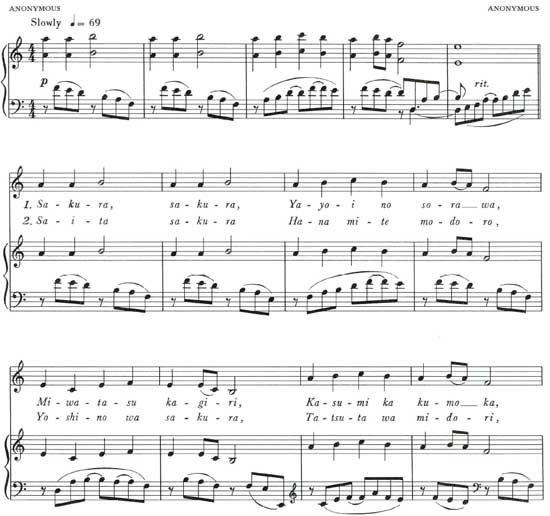
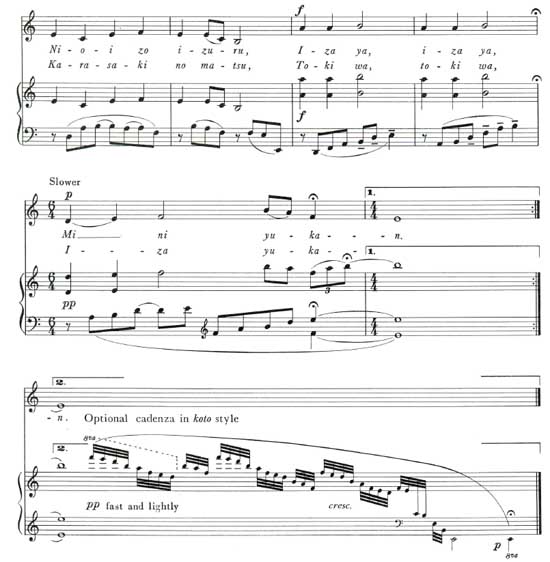
This is an example of the studied form of court poetry and music of ancient Japan. The first verse, in a literal translation by Grace Saito, goes: "Cherry blossoms! Cherry blossoms! In the March sky as far as one can see, like mist, like clouds... Their fragrance is everywhere. Come, come, let's go and see." This verse, containing an element of mysticism, was written in the nineteenth century and is now probably better known than the second, which is the older text. The second verse is also a more direct and simple concept: "After seeing the full-blown blossoms let's return home. It's Yoshino for cherry blossoms, Tatsuta for maple leaves, and Karasaki for pine trees. Always and always let's go."
Next page
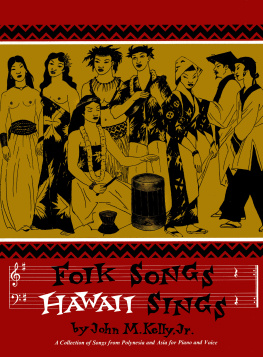

![Robert Choi - Korean Folk Songs: Stars in the Sky and Dreams in Our Hearts [14 Sing Along Songs with the Downloadable Audio included]](/uploads/posts/book/423508/thumbs/robert-choi-korean-folk-songs-stars-in-the-sky.jpg)
